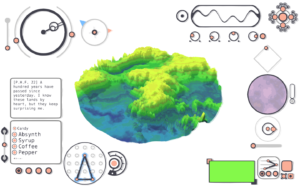Kao: Levels and Lives
Unlike most games in the cartoon-animal-based 3D platformer its genre, Denis the Inadvertently Non-Binary Kangaroo doesn’t involve rescuing anyone. The intro movie to shows our hero being trapped and caged by a hunter, so perhaps there’s some other kangaroo out there trying to rescue you, but as far as I can tell, nothing within the rest of the game reflects or references your abduction in any way. Instead, you just get a series of levels in sundry random environments, including tropical islands, caves, and icy mountains, where your goal in each is to reach the exit and pick up as many coins as you can along the way. Occasionally there’s a boss. The readme explains that Denis escaped captivity some time between the intro and the first level, and is trying to make his way back home to Australia. I don’t know what his starting point is, but he’s taking an awfully roundabout route regardless.
The reason you want to collect coins, apart from “because they’re there”, is that every 50 coins you collect gives you an extra life. Yes, there are limited lives, but it’s not as bad as it could be. You can save your progress between levels, and there are multiple save slots. I’ve been using the topmost slot as a “This is the farthest I’ve gotten without losing any lives” slot, which I periodically return to and attempt to advance it further when I run out of lives in my more advanced runs. I wind up replaying levels a lot, but that would be the case anyway. It’s very much a practice-makes-perfect game.
The treatment of checkpoints is a little peculiar. I’m not entirely sure I actually understood how they worked back when I first got the game; this could have contributed to the frustration that led me to abandon the game at level 3. The idea is: Checkpoints are collectables. You pick them up, and then you drop them wherever you want to respawn when you die. The thing is, they’re in limited supply, so that gives you a reason to hoard them. And that gives the whole thing a press-your-luck aspect. You’ve just come through a difficult bit. Do you drop a checkpoint now, or do you wait a little longer? If you die before using the checkpoint, you have to go through the difficult section again. On the other hand, if you drop a checkpoint and then finish the level without dying, you’ve basically wasted a checkpoint. What you really want to do is, of course, practice the level until you can complete it without losing any lives, at which point you won’t need to use any checkpoints. Checkpoints are mainly useful for getting that practice.
 Comments(0)
Comments(0)